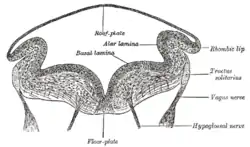Solitary nucleus
In the human brainstem, the solitary nucleus, also called nucleus of the solitary tract, nucleus solitarius, and nucleus tractus solitarii, (SN or NTS) is a series of purely sensory nuclei (clusters of nerve cell bodies) forming a vertical column of grey matter embedded in the medulla oblongata. Through the center of the SN runs the solitary tract, a white bundle of nerve fibers, including fibers from the facial, glossopharyngeal and vagus nerves, that innervate the SN. The SN projects to, among other regions, the reticular formation, parasympathetic preganglionic neurons, hypothalamus and thalamus, forming circuits that contribute to autonomic regulation. Cells along the length of the SN are arranged roughly in accordance with function; for instance, cells involved in taste are located in the rostral part, while those receiving information from cardio-respiratory and gastrointestinal processes are found in the caudal part.[1][2]
| Solitary nucleus | |
|---|---|
 The cranial nerve nuclei schematically represented; dorsal view. Motor nuclei in red; sensory in blue. | |
 Transverse section of medulla oblongata of human embryo. | |
| Details | |
| Identifiers | |
| Latin | Nucleus tractus solitarii medullae oblongatae. |
| MeSH | D017552 |
| NeuroNames | 742 |
| NeuroLex ID | birnlex_1429 |
| TA98 | A14.1.04.230 |
| TA2 | 6008 |
| FMA | 72242 |
| Anatomical terms of neuroanatomy | |
Inputs
- Taste information from the facial nerve via the chorda tympani (anterior 2/3 of the tongue), glossopharyngeal nerve (posterior 1/3) and vagus nerve (small area on the epiglottis)
- Chemoreceptors and mechanoreceptors of the general visceral afferent pathway (GVA) in the carotid body via glossopharyngeal nerve, aortic bodies, and the sinoatrial node, via the vagus nerve
- Chemically and mechanically sensitive neurons of the general visceral afferent pathway (GVA) with endings located in the heart, lungs, airways, gastrointestinal system, pharynx, and liver via the glossopharyngeal and vagus nerves. Organ specific regions of neuronal architecture are preserved in the solitary nucleus.[3] Additional minor GVA input from the nasal cavity, soft palate and sinus cavities enters via the facial nerve.[4]
Neurons that innervate the SN mediate the gag reflex, the carotid sinus reflex, the aortic reflex, the cough reflex, the baroreceptor and chemoreceptor reflexes, several respiratory reflexes and reflexes within the gastrointestinal system regulating motility and secretion.
Neurons which transmit signals about the gut wall, the stretch of the lungs, and the dryness of mucous membranes also innervate the SN. The first central neurons within the SN can participate in simple autonomic reflexes.
Outputs
Information goes from the solitary nucleus to a large number of other regions of the brain including the paraventricular nucleus of the hypothalamus and the central nucleus of the amygdala, as well as to other nuclei in the brainstem (such as the parabrachial area, the locus coeruleus, the dorsal raphe nucleus, and other visceral motor or respiratory networks).[5] The signals projected from the SN to the parabrachial area originate in the oral cavity and gastrointestinal tract. The pathways for gastric and gustatory (taste) processes are believed to terminate in different subdivisions of the parabrachial area, but still interact in the SN.[6][7] Some neuronal subpopulations in the SN, such as the noradrenergic cell group A2 and the aldosterone-sensitive HSD2 neurons project as far ventral as the bed nucleus of the stria terminalis.[8][9]
Additional images
 Section of the medulla oblongata at about the middle of the olive.
Section of the medulla oblongata at about the middle of the olive. Primary terminal nuclei of the afferent (sensory) cranial nerves schematically represented; lateral view.
Primary terminal nuclei of the afferent (sensory) cranial nerves schematically represented; lateral view.
See also
References
- Duane E. Haines (2004). Neuroanatomy: An Atlas of Structures, Sections, and Systems. Lippincott Williams & Wilkins. pp. 186–. ISBN 978-0-7817-4677-9. Retrieved 22 January 2013.
- P. Michael Conn (2008). Neuroscience in Medicine. Springer. p. 264. ISBN 978-1-60327-455-5. Retrieved 22 January 2013.
- Ran, C.; Boettcher, J.C.; Kaye, J.A. (2022). "A brainstem map for visceral sensations". Nature. doi:10.1038/s41586-022-05139-5.
- Dulak, Dominika; Naqvi, Imama A (2020). Neuroanatomy, Cranial Nerve 7 (Facial). StatPearls. StatPearls Publishing. PMID 30252375. Retrieved 2018-10-27.
- Carlson, Neil R. (2010). Physiology of Behavior (10th ed.). Allyn & Bacon. p. 253. ISBN 978-0-205-66627-0.
- Karimnamazi, Hamid; Travers, Susan P; Travers, Joseph B (2002). "Oral and gastric input to the parabrachial nucleus of the rat". Brain Research. 957 (2): 193–206. doi:10.1016/S0006-8993(02)03438-8. PMID 12445962.
- Karimnamazi, Hamid; Travers, Joseph B. (1998). "Differential projections from gustatory responsive regions of the parabrachial nucleus to the medulla and forebrain". Brain Research. 813 (2): 283–302. doi:10.1016/S0006-8993(98)00951-2. PMID 9838165.
- Geerling, JC; Loewy, AD (Jul 2006). "Aldosterone-sensitive neurons in the nucleus of the solitary tract: efferent projections". J Comp Neurol. 497 (2): 223–50. doi:10.1002/cne.20993. PMID 16705681.
- Shin, JW; Geerling, JC; Loewy, AD (Dec 2008). "Inputs to the ventrolateral bed nucleus of the stria terminalis". J Comp Neurol. 511 (5): 628–57. doi:10.1002/cne.21870. PMC 2748802. PMID 18853414.